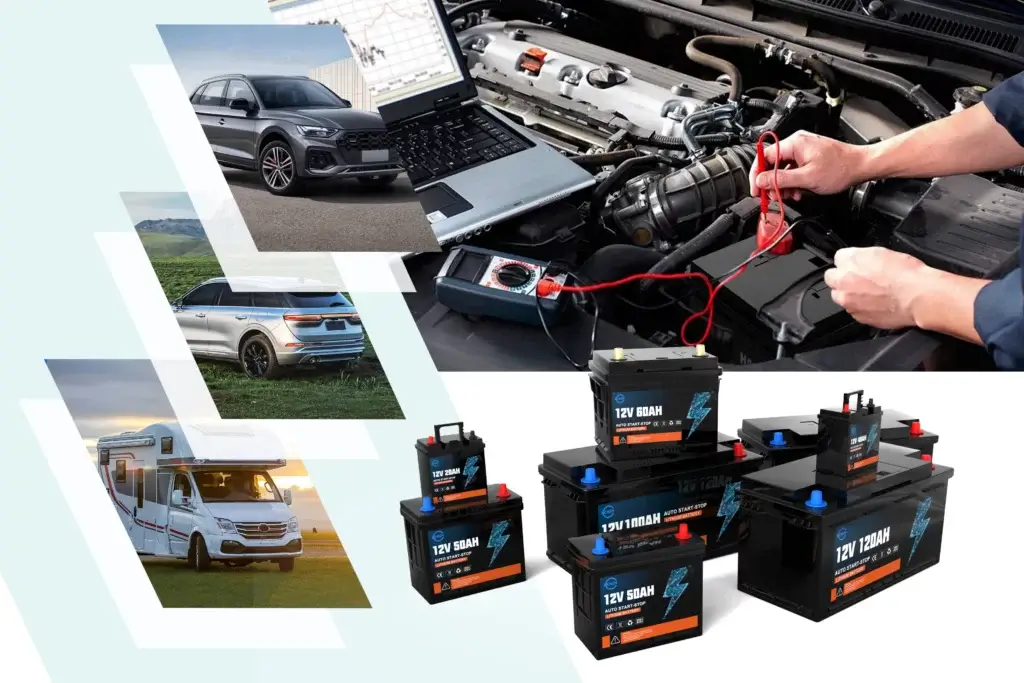With so many choices available, selecting the right car battery can feel overwhelming. Don’t worry! This guide simplifies the key information you need to know, including car battery types, how to identify them, voltage, size, and key features. With this guide, you’ll become an expert, ready to make the best decision for your vehicle.

Part 1: Car Battery Types
When it comes to car batteries, there are several types to choose from. Each has its own advantages and is suitable for different needs. Let’s take a closer look at the most common options:
1. Lead-Acid Batteries (Flooded/Wet Cell)
Lead-acid batteries are a classic choice and have been around for decades. These are the most common car batteries you’ll find and are easily identified by their removable caps used for maintenance. While they require regular maintenance, such as checking and topping up with distilled water, they are affordable and provide reliable performance for most standard vehicles.
2. AGM Batteries (Absorbent Glass Mat)
If you need a more advanced battery, consider an AGM battery. These sealed, maintenance-free batteries do not require water level checks and offer improved performance and a longer lifespan compared to flooded batteries. They are ideal for vehicles with high electrical demands, such as those with numerous electronic features. To learn more about AGM and deep cycle batteries, check out [Understanding AGM Batteries vs Deep Cycle Batteries](https://lithiumbatterytech.co.za/understanding-agm-batteries-vs-deep-cycle-batteries/).
3. Gel Batteries (Colloid)
Gel batteries are similar to AGM batteries but use a gelled electrolyte instead of a liquid. This makes them maintenance-free, so they perform well, especially in deep cycle applications (applications where the battery is regularly deeply discharged and recharged). While less common, they are an excellent choice for specific uses, such as in marine or recreational vehicles.
4. Lithium-Ion Batteries
Lithium-ion batteries represent a growing trend in car battery technology. They are much lighter than traditional lead-acid batteries and have a longer lifespan. However, they are more expensive. Due to their efficiency and lifespan, these batteries are often used in high-performance and electric vehicles.
Part 2: How to Identify Your Car Battery Type
Understanding your car battery type is crucial for maintenance and replacement. Here are some useful tips to help you identify your car battery:
1. Check the Label
The easiest way to identify your battery type is to look at the label. It usually includes information about the battery type, voltage, and capacity. Manufacturers typically provide this information.
2. Inspect the Battery
Take a close look at your battery. Flooded lead-acid batteries often have removable caps for inspection.
Part 4: Car Battery Sizes
Choosing the right battery size for your car is crucial. Car batteries come in different sizes, and ensuring you select the correct size guarantees proper installation and operation. The Battery Council International (BCI) group number standardizes battery sizes, so understanding this is important when selecting a battery for your vehicle.
BCI Group Number:
This number indicates the battery’s size. For example, a group 35 battery is typically about 9.1 inches long, 6.9 inches wide, and 8.9 inches tall. Knowing the BCI group number helps you select the right battery, ensuring a secure fit in your car’s battery tray.
Battery Installation:
Ensure the battery is correctly installed in the battery tray. An improperly sized battery that’s loose can lead to damage, while one that’s too large simply won’t fit.
Terminal Location:
Battery terminal locations can vary. It’s essential to ensure the terminal location is compatible to avoid connection issues. Some batteries have top-mounted terminals, while others have side-mounted terminals.
Part 5: Key Parameters of Car Batteries
Several key factors affect a car battery’s performance. Understanding these parameters will help you choose the best battery for your needs.
Cold Cranking Amps (CCA):
The CCA rating reflects the battery’s ability to start the engine in cold temperatures. A higher CCA value is especially important in colder climates. For example, a higher CCA ensures your car can start even in freezing winter conditions.
Reserve Capacity (RC):
The RC value measures how long the battery can power the vehicle’s electrical system if the alternator fails. A higher RC means the battery can sustain the car’s electrical demands for a longer period. This is especially important if your vehicle has many power-dependent electronic features.
Ampere-Hour (Ah):
This rating indicates the battery’s energy storage capacity. It indicates how long the battery can power your vehicle before requiring a recharge. A higher Ah rating means the battery can store more energy, providing a longer runtime.
Part 6: Which Battery is Right for My Car?
Selecting the right battery for your car requires careful consideration. Here’s a step-by-step guide to choosing the appropriate battery.
1. Check Your Owner’s Manual:
Your car’s owner’s manual is the best resource for finding the recommended battery type, size, and specifications. This ensures you select the ideal battery for optimal performance.
2. Consider Your Driving Conditions:
Evaluate your local climate and driving habits. If you live in a colder region, opt for a battery with a higher CCA rating.

### Choosing the Right Car Battery for Your Vehicle
In conclusion, understanding the various types of car batteries, how to identify them, and the essential parameters to look for is crucial for maintaining your vehicle’s optimal performance. By knowing key aspects like voltage, size, and critical characteristics such as CCA (Cold Cranking Amps) and RC (Reserve Capacity, also known as Reserve Capacity), you can make informed decisions when purchasing a new battery. When selecting a battery, consider factors such as your driving habits, the electrical demands of your vehicle, and your budget. With this guide, you’ll be able to choose the perfect battery for your car, ensuring smooth and reliable performance. The next time you need a replacement, you’ll know how to choose.







